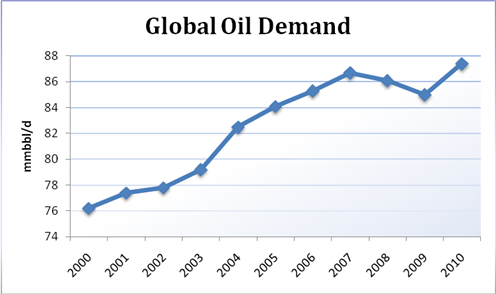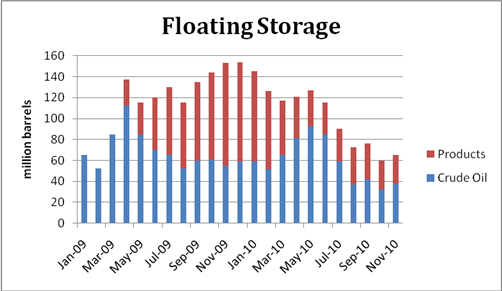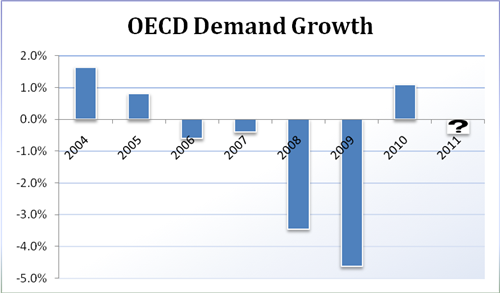Non-OPEC Supply, OECD Demand are Key as Oil Eyes $100
After falling for two years in a row, oil demand rebounded sharply in 2010 to reach a new record high. At 87.4 million barrels per day, the year’s demand rose by 2.4mmbbl/d, or 2.8%, according to figures from the International Energy Agency. That is the fastest growth since 2004.

Much of 2010’s robust growth can be attributed to recovery from an especially dismal 2008 and 2009. The steep declines in consumption we saw in developed economies were partially reversed, though Europe put in yet another decline. Demand in the region has not risen since 2004. North America fared better, as demand rose almost 0.6mmbbl/d.
While demand from developed economies bounced back, that from emerging markets absolutely surged. Non-OECD consumption rose by a full 2mmbbl/d, representing over 80% of the year’s total demand growth. China alone accounted for 0.7mmbbl/d of said demand, or 30% of total demand growth.

Taking a look at the other side of balances, supply also put in an impressive performance in 2010. In particular, non-OPEC supply rose by 1.1mmbbl/d, or 2.1%, its best showing since 2004 when it rose by 2.4%. This took the burden off of OPEC, which saw its crude output climb a modest 0.5mmbbl/d, as the cartel maintained a solid level of spare capacity. Effective spare capacity stands at 5.56mmbbl/d per the IEA, well above the 1-3mmbbl/d level back during the last oil bull market during the 2003-2008 period.

A fairly balanced year for supply and demand had inventories in the OECD steady. But while inventories are largely flat year-over-year, they are well below the mid-summer peak and trending lower. Moreover, floating storage has more than halved from a year ago, standing at 64 million barrels in November, down from a peak of 154 million barrels at the end of 2009.

Turning to the new year, the IEA sees demand growth slowing to 1.4mmbbl/d, or 1.6%, in 2011, close to the 2005-2007 average growth rate of 1.7%. Non-OECD growth will slow from 5.1% to 3.9%, which is just slightly below the 2005 to 2007 average of 4.1%. OECD demand is expected to resume its structural decline, dropping by 0.2mmbbl/d. Prior to 2010, OECD demand had fallen in every year since 2005 as the new high oil price paradigm led to increasing conservation and advances in efficiencies.
On the supply side, non-OPEC production may rise by 0.6mmbbl/d, or 1.1%, nearly half the growth rate of 2010. Somewhat surprisingly, the IEA sees North American production falling 0.2mmbbl/d after rising 0.5mmbbl/d due in part to drilling restriction in the Gulf of Mexico that were instituted following the BP Macondo well disaster. But furious drilling onshore in North America continues, which has enabled U.S. production to reach a six-year high. It is very possible that the IEA could be underestimating non-OPEC production growth.
At 29.2mmbbl/d, OPEC crude oil production stands only slightly below the IEA’s estimate of the 29.5mmbbl/d that will be necessary to keep OECD inventories flat in 2011. Of course, there are many risks to this outlook. As we stated previously, non-OPEC production growth could surprise to the upside. That would loosen the market, all else equal. On the other hand, in the event OECD demand surprises to the upside- bucking the call for resumption in the secular decline- that would tighten the market more than expected.
All things considered, benchmark crudes have accounted for quite a bit of bullishness with prices sitting in the mid-$90’s. There will likely need to be evidence that the market has tightened more-than-expected before a move into the triple digits. As stated above, the bullish wildcard is demand growth from developed economies, while the bearish wildcard is non-OPEC supply. Additional variables to consider include China’s demand growth as the country’s central bank tightens monetary policy and OPEC crude supply as Iraq lifts production and quota compliance falls due to higher prices.

DailyFX provides forex news on the economic reports and political events that influence the currency market.
Learn currency trading with a free practice account and charts from FXCM.






1 comment:
Hello Everybody,
I've included a list of the most recommended FOREX brokers:
1. Most Recommended Forex Broker
2. eToro - $50 min. deposit.
Here is a list of money making forex instruments:
1. ForexTrendy - Recommended Odds Software.
2. EA Builder - Custom Strategies Autotrading.
3. Fast FX Profit - Secret Forex Strategy.
I hope you find these lists beneficial.
Post a Comment